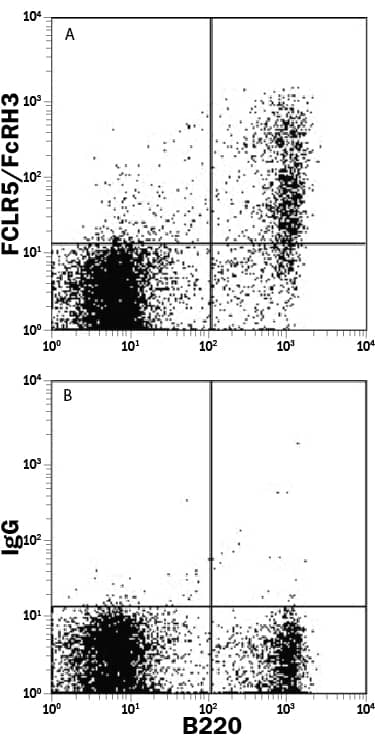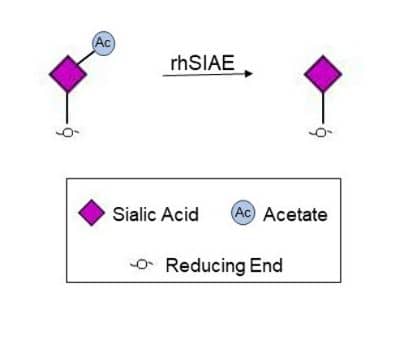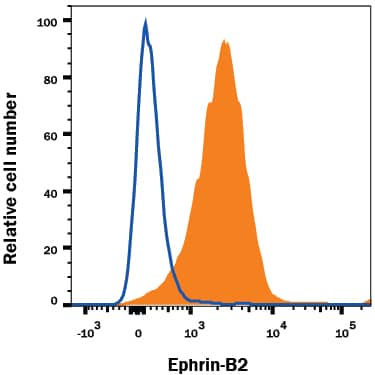Mouse FCRL5/FcRH5 Antibody Summary
Gln27-Ala496 (predicted)
Accession # NP_899045
Customers also Viewed
Applications
Please Note: Optimal dilutions should be determined by each laboratory for each application. General Protocols are available in the Technical Information section on our website.
Scientific Data
 View Larger
View Larger
Detection of FCRL5/FcRH3 in Mouse Splenocytes by Flow Cytometry. Mouse splenocytes were stained with Sheep Anti-Mouse FCRL5 Antigen Affinity-purified Polyclonal Antibody (Catalog # AF6757) followed by Allophycocyanin-conjugated Anti-Sheep IgG Secondary Antibody (Catalog # F0127) and Rat Anti-Mouse B220/CD45R PE-conjugated Monoclonal Antibody (Catalog # FAB1217P). Quadrant markers were set based on control antibody staining (Catalog # 5-001-A).
Preparation and Storage
- 12 months from date of receipt, -20 to -70 °C as supplied.
- 1 month, 2 to 8 °C under sterile conditions after reconstitution.
- 6 months, -20 to -70 °C under sterile conditions after reconstitution.
Background: FCRL5
Fc Receptor-Like 5 (FCRL5), also known as FcRH3 (FcRH5 in human), IRTA2, and CD307e, is a 90‑95 kDa member of the FCRL family of proteins whose amino acid (aa) sequence is reminiscent of that for classical Fc receptors. FCLR molecules are type 1 transmembrane proteins that contain from three to nine immunoglobulin-like domains. They are differentially expressed within the B cell lineage, and can either promote or inhibit B cell proliferation and activation (1, 2, 3). Mature mouse FCRL5 consists of a 470 aa extracellular domain (ECD), a 21 aa transmembrane segment, and a 79 aa cytoplasmic region. The ECD contains five Ig-like domains, while the cytoplasmic region possesses one ITAM-like motif and one immunotyrosine inhibitory motif (ITIM) (1, 3, 4). There are two major alleles for FCLR5 in mouse. The first was just described, and is found in BALB/c plus NZB mouse strains. The second is found in C57BL/6 mice, and differs by eleven scattered aa in the ECD. This creates one additional N-linked glycosylation site, and increases the SDS‑PAGE MW by 5 kDa (3). Alternate splicing of mouse FCRL5 generates at least one additional isoform that lacks the first Ig-like domain (aa 3‑90 of the mature molecule) (4). Human FCRL5, by contrast, contains up to nine Ig-like domains in a highly variable ECD, and over common regions, mouse and human FCRL5 share 49% aa sequence identity. CRL5 expression is restricted to mature B lineage cells in lymphoid tissues and blood, and is particularly noted to be expressed on T‑independent marginal zone and B1 B cells (3-8). Its ligation inhibits signaling through the B cell antigen receptor (9). Epstein-Barr virus transformation of B cells induces the up‑regulation of surface FCRL5 by a direct effect of its EBNA2 protein on FCRL5 gene transcription (10). FCRL5 on B cells functions as a receptor for the orthopoxvirus MHC class I-like protein OMCP (11). And based on the literature and R&D Systems testing, both mouse and human FCRL5 will bind to purified IgG with high affinity (5). In human, the FCRL5 gene maps to the 1q21 chromosomal locus, a common site of rearrangements in B cell malignancies. Notably, the FCRL5 protein is preferentially expressed in cell lines with 1q21 abnormalities, and is up‑regulated on tumor cells in some types of B cell malignancies (5, 7, 12‑14). In addition, soluble FCRL5 is elevated in the serum of many B cell leukemia patients (13, 15).
- Davis, R.S. (2007) Annu. Rev. Immunol. 25:525.
- Maltais, L.J. et al. (2006) Nat. Immunol. 7:431.
- Won, W-J. et al. (2006) J. Immunol. 177:6815.
- Davis, R.S. et al. (2004) Int. Immunol. 16:1343.
- Hatzivassiliou, G. et al. (2001) Immunity 14:277.
- Miller, I. et al. (2002) Blood 99:2662.
- Polson, A.G. et al. (2006) Int. Immunol. 18:1363.
- Vidal-Laliena, M. et al. (2005) Cell. Immunol. 236:6.
- Haga, C.L. et al. (2007) Proc. Natl. Acad. Sci. 104:9770.
- Mohan, J. et al. (2006) Blood 107:4433.
- Campbell, J.A. et al. (2010) J. Immunol. 185:28.
- Ise, T. et al. (2005) Clin. Cancer Res. 11:87.
- Ise, T. et al. (2007) Leukemia 21:169.
- Kazemi, T. et al. (2009) Cancer Immunol. Immunother. 58:989.
- Ise, T. et al. (2006) Clin. Chem. Lab. Med. 44:594.
Product Datasheets
FAQs
No product specific FAQs exist for this product, however you may
View all Antibody FAQsIsotype Controls
Reconstitution Buffers
Secondary Antibodies
Reviews for Mouse FCRL5/FcRH5 Antibody
There are currently no reviews for this product. Be the first to review Mouse FCRL5/FcRH5 Antibody and earn rewards!
Have you used Mouse FCRL5/FcRH5 Antibody?
Submit a review and receive an Amazon gift card.
$25/€18/£15/$25CAN/¥75 Yuan/¥2500 Yen for a review with an image
$10/€7/£6/$10 CAD/¥70 Yuan/¥1110 Yen for a review without an image


















